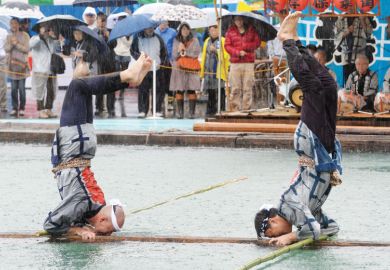Hideo Ohno believes Japan’s culture of innovation has stagnated. The president of Tohoku University says the country has lost the dynamism it had in the glory days of the 1970s and 1980s, when it ruled the world of consumer electronics.
The thoughtful physicist also offers a more philosophical explanation, in the vein of “what goes up, must come down”: “It’s a price, if I may say, of being successful at one time.”
In the latest in our Talking Leadership series, Ohno explains why he thinks Japan may be on the up again, his experience of the 2011 Tohoku earthquake and its profound impact on Japanese society, and why he is trying to make his institution more welcoming to foreigners.
Tohoku University is on a mission to boost its data-driven science and technology output. It is investing hundreds of millions of dollars – funded partly by the government and partly by industry – in a new science park that will be a one-stop shop for scientific measurement. Researchers from Tohoku and other universities, as well as from industry, will be able to use the facility, which will house a 100nm X-ray microscope, MRI machines and more. Those working on materials science, agriculture, life science and beyond will make use of it, Ohno says.
THE Campus views: How can we solve Japan’s student mobility issues?
It is endeavours such as this that will put Japan back on the global innovation map, according to Ohno: “I believe we lacked that part [dynamism]. And we are now trying to get back [on] track.”
He also identifies a change in the underlying purpose of much of the research and other initiatives happening in Japan, compared with a decade ago. Since the 2011 earthquake devastated the country – it was the most powerful earthquake ever recorded in Japan – universities, businesses and government have shifted their focus to benefiting society, he says. One project he cites as an example is a huge cohort study of 150,000 people; he says he was able to persuade the government to fund such a large study because of the earthquake.
“I believe the UK and the US tried to establish such a cohort but failed because they couldn’t get enough participants,” he adds.
The day of the earthquake
On 11 March 2011, the day of the earthquake, Ohno, a professor at the time, was on the fourth floor of a Tohoku University building reporting to an advisory board. The building began to sway and objects fell from the ceiling. It was the third shock that made him realise a lot of lives were going to be lost.
He left the building with his colleagues. They found a safe place, and once the emergency generator kicked in, they watched the tragedy unfold on the news. At this point, there were reports of 200 deaths. Ultimately about 20,000 people would lose their lives to the earthquake and the tsunami it caused, including three students from the university.
In the month immediately after the disaster, even before they had electricity back on campus, Tohoku set up an institute for disaster reconstruction and regeneration. In the years that followed, hundreds of projects have been developed with the aim of supporting society.
It is initiatives such as these that will reinvigorate Japan, Ohno believes: “We have to always reinvent ourselves – not just Japan, but other countries as well.”
Internationalisation
One area that Ohno knows the university needs to reinvent is internationalisation. Japan has a reputation for being somewhat unwelcoming to foreign faculty.
“Probably there’s some truth in it,” Ohno admits. “And that’s something that we need to change.”
His strategy is to hire part-time staff. “Recruiting full-time is still not very easy – because of the language, because of the customs, because of many other things.”
These part-time international academics don’t usually live in Japan, but without Covid restrictions they would spend some time on campus.
A significant hindrance to the integration of international staff is faculty meetings held in Japanese; Ohno is planning to gradually introduce the use of English and, ultimately, to make it mandatory. Does he think there is a downside to the “English-ification” of higher education?
Again, he offers a considered response: “Well, there’s always a certain negative side if you want to change something. But…I think it gives us more benefits than negative effects.”
The part-time faculty roles should also help the university to recruit more women, Ohno hopes, as he is set on Tohoku improving its gender balance. The university also has a campus nursery with 266 places, which it hopes will assist with this.
Most of the world has a problem with gender parity in STEM subjects, but Ohno says Japan is “lagging far behind”. Is this because of cultural factors?
“Well, it’s easy to blame culture. I think it’s part of the reason, but somehow we haven’t been able to change this notion of ‘mathematics, physics and chemistry are for boys’. And this inertia is still there,” Ohno says.
“You can call it culture, but culture is something important. And I don’t want to think that this is an important culture for us,” he continues.
Ohno feels that Tohoku has a special role in leading the way on this because of its legacy as the first university in Japan to admit female students in 1913.
From research to administration
Ohno himself is a world-renowned expert on spintronics, the study of the intrinsic spin of the electron. He was tipped as a possible candidate to win a Nobel prize in 2011 in Clarivate’s Citation Laureates list, but he modestly deflects the accolade with humour: “Well, um, first of all, this Nobel thing is a good advertisement of Clarivate Analytics.” He then quickly moves the discussion on to the eight other highly cited academics at Tohoku.
Born in Tokyo to parents who were theoretical physicists, he spent most of his upbringing in Japan, with a couple of stints in Sweden and Florida.
After completing his BSc and MSc at the University of Tokyo in 1979, he considered going into business and working for the government before settling on a PhD and the academic life. Does he think he made the right choice? Again, he offers a more philosophical answer than might be expected. “I try to think that I have always made the right choice. Even if it wasn’t.”
Ohno remembers his professor father having to deal with student riots in the early 1970s, when protests against the US-Japan security treaty erupted into cars and buses being set on fire. He doesn’t condone the violence but does think Japanese students today are less political – a topic he discusses with a hint of sadness.
“It’s hard for me to understand, but there is no strong sort of sense of political, let’s say, participation,” he says. He is not sure why.
“It may be associated with [a] stagnant sort of feeling about a society, or being in a stagnant society,” he suggests.
Young Japanese people are trained to follow rules, he adds, but they’re not aware that they can change them “to make [them a] better fit with their society, or their view of society”.
“I see many possibilities in them. And I would like them to be aware of it…I would like to see them aware of their potential, basically. They’re the future of our society and [the] future of our world.”
rosa.ellis@timeshighereducation.com
Quick facts
Born: Tokyo, 1954
Academic qualifications: BSc, MSc and PhD in electronic engineering from the University of Tokyo
Lives with: His wife. He has two grown sons.
Academic hero: “I’ve never really had a hero, but I do respect Leo Esaki and Hiroyuki Sakaki as scientists.”
This is part of our “Talking leadership” series of 50 interviews over 50 weeks with the people running the world’s top universities about how they solve common strategic issues and implement change. Follow the series here.
View the THE Japan University Rankings 2022 results
Register to continue
Why register?
- Registration is free and only takes a moment
- Once registered, you can read 3 articles a month
- Sign up for our newsletter
Subscribe
Or subscribe for unlimited access to:
- Unlimited access to news, views, insights & reviews
- Digital editions
- Digital access to THE’s university and college rankings analysis
Already registered or a current subscriber?











